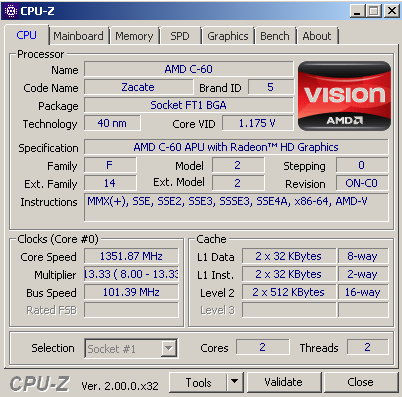Comparing: AMD C-60 vs Intel Core i7 7700K
In this comparison, we analyze two Processors: AMD C-60 and Intel Core i7 7700K, using synthetic benchmark tests to evaluate their overall performance. This side-by-side comparison helps users understand which hardware delivers better value, speed, and efficiency based on standardized testing. Whether you're building a new system or upgrading an existing one, this benchmark-driven evaluation offers valuable insights to guide your decision.
Specification Comparison Table
This specification comparison presents technical details of several devices or components to help you understand the key differences between each option. Use this table as a reference to determine which device best suits your needs.
| Specification | AMD C-60 | Intel Core i7 7700K |
|---|---|---|
| Architecture | x86 | x86 |
| Technology | 40 nm | 14 nm |
| Clock | 1 GHz - 1.3 GHz | 4.2 GHz - 4.5 GHz |
| Core/Thread | 2 / 2 | 4 / 8 |
| Segmen | Mobile | Desktop |
Submission Comparison Table
This submission comparison table displays the number and details of benchmark data submissions from various devices or components. This information helps you understand the performance based on the benchmarks that have been tested, as well as providing an overview of the consistency and popularity of the available benchmark results.
| No. | Benchmark Software | AMD C-60 | Intel Core i7 7700K |
|---|---|---|---|
| 1 | PiFast |
2min, 14sec, 820ms |
14sec, 730ms |
| 2 | SuperPi - 1M |
1min, 139ms |
30sec, 414ms |
Submission Comparison Chart
This chart visualizes the benchmark scores comparison between two hardware devices based on submitted data.
Media Gallery
A collection of photos of tested hardware. These images can help you identify the physical form, model, and variant of the hardware in question. These photos are from our own documentation, and if they are not available we may not be able to document them.
About Hardware AMD C-60
Released in 2011, the AMD C-60 is a power-efficient processor from the Ontario series built on the Bobcat architecture. It has 2 cores and 2 threads, with a base speed of 1.0 GHz that can be increased to 1.33 GHz through Turbo Core technology. Designed specifically for portable devices such as netbooks and ultraportable laptops, the C-60 is focused on power efficiency and long battery life rather than high performance. With a TDP of just 9 watts, this processor enables ultra-thin and lightweight laptop designs without the need for complex active cooling systems. The main advantage of the C-60 is its extremely low power consumption, making it an attractive solution for users who need a lightweight computing device for daily activities with high mobility.
The AMD C-60 is also equipped with an integrated Radeon HD 6290 GPU, which has 80 shader cores and supports DirectX 11. Despite its modest specifications, this GPU is sufficient for multimedia purposes such as HD video playback, light graphics rendering, and old-school games with minimal graphics settings. However, overall, the performance of the AMD C-60 is limited and only suitable for light tasks such as browsing, typing documents, and using basic office applications. This processor will feel slow when used for heavy multitasking, modern software installation, or complex web-based applications. In tests using an Acer Aspire One 522 paired with 2GB DDR3 RAM and Windows 7 operating system, the processor was able to provide a decent user experience for basic needs, but was less responsive when compared to mainstream processors of the same generation. Even so, the AMD C-60 remains a viable solution for low-cost, power-efficient devices of its time.
Hardware Detail:
Device: Acer Aspire One 522
RAM: 2GB DDR3
OS: Windows 7
Friday, 08 April 2022 17:00:00 | Update: 1 month ago
About Hardware Intel Core i7 7700K
The Intel Core i7-7700K, launched in early 2017, is a high-performance desktop processor from the 7th generation Kaby Lake family. Built on the 14nm process, the i7-7700K features 4 physical cores and 8 threads, thanks to Hyper-Threading Technology, and is targeted at enthusiasts, gamers, and power users. It operates at a base frequency of 4.2 GHz and can boost up to 4.5 GHz via Intel Turbo Boost, delivering excellent single-threaded performance one of the highest at the time of its release.
As part of Intel’s “K” series, the Core i7-7700K has an unlocked multiplier, making it ideal for overclocking on compatible Z-series motherboards. However, with a TDP of 91W, the processor demands an effective cooling solution, especially when overclocked beyond its stock speeds. Users typically pair this CPU with aftermarket air or liquid coolers to ensure thermal stability under heavy workloads or gaming sessions.
The processor includes Intel HD Graphics 630, which supports 4K output at 60Hz and is sufficient for basic tasks like web browsing, video playback, and office work. However, for serious gaming or GPU-accelerated workloads, a discrete graphics card is still necessary, especially when paired with a high-refresh-rate monitor or demanding software.
In terms of real-world performance, the i7-7700K remains capable even today for 1080p and 1440p gaming, general productivity, and creative tasks. It delivers solid frame rates in many modern titles when used with a modern GPU, and it handles applications like Adobe Photoshop, Premiere Pro, and coding environments reasonably well. However, due to its limited core count by today’s standards and lack of PCIe 4.0 support, it has started to show its age in multi-threaded and next-gen workloads.
Despite being surpassed by newer Intel and AMD CPUs with more cores and better efficiency, the i7-7700K still holds value in many mid-range desktop setups, especially for users who already own an LGA 1151 system and want to maximize performance without a full platform upgrade.
Thursday, 23 June 2022 07:42:37 | Update: 1 month ago



